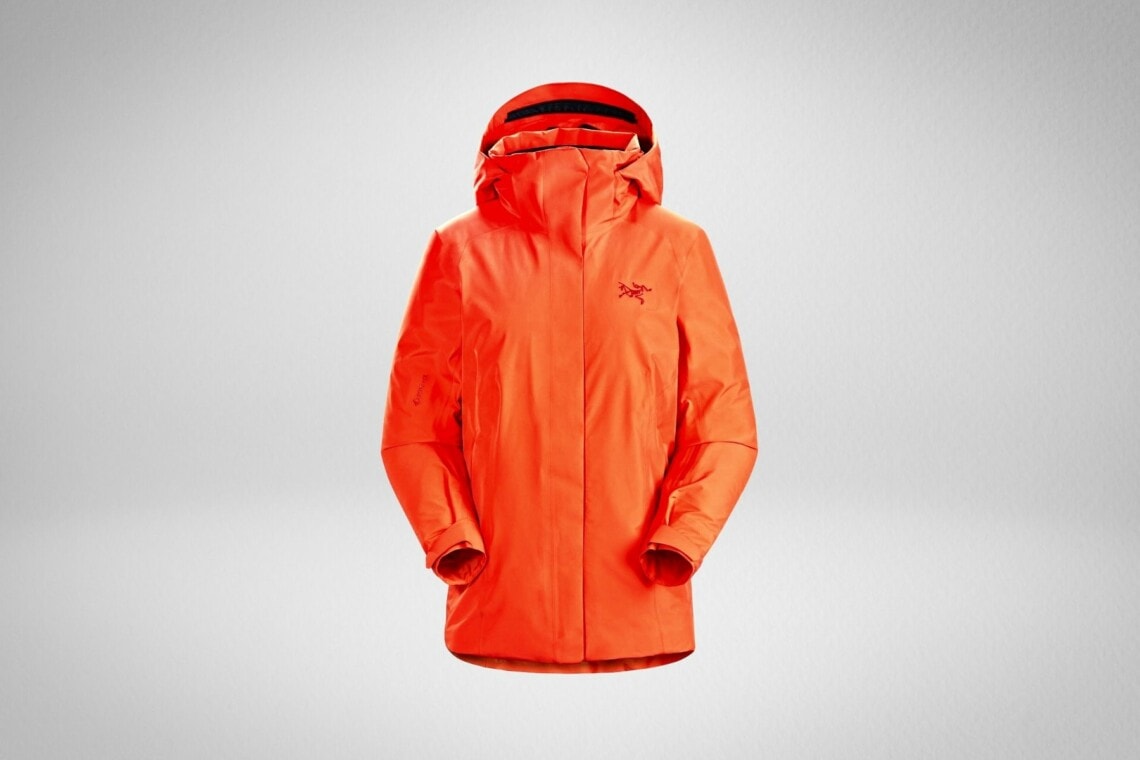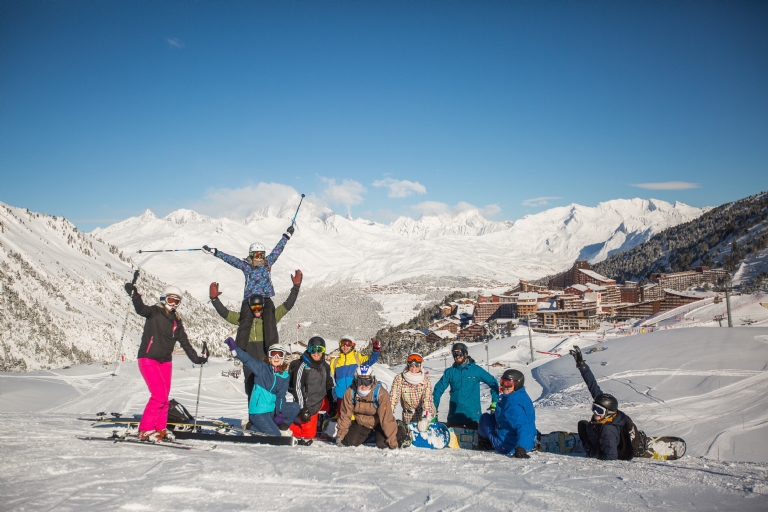
Skis that perform well in all-mountain or freeride conditions are options. But it is important to choose the right one for you.
What's the difference between all mountain and freeride?
This ski range is for the "jack-of-all trades", those who enjoy trying different types of slopes during the day. These skis can handle everything: groomed slopes to fresh powder, crust, moguls, and crud.
They tend to be a bit wider than piste skis and have a rocker profile to help them float on soft snow. They have a long, progressive rockered tip that allows them to turn more easily and makes it easier to maneuver in varied snow off-piste.
There are many options for length, but the most suitable ones for difficult terrain or deep powder are the longer models. Start with a shorter length to make your first turns easier.

If you are more experienced at carving, you may prefer shorter skis. These skis are slightly lighter than a freeride model so they will be more flexible and less heavy.
All-mountain skiing is great for intermediate and beginners who want to ski on a variety of slopes. They are also great for intermediate and advanced skiers who want to master the lift before they venture into off-piste territory.
All-mountain skiing is wider than the freeride model. It also has a wider underfoot (100mm–115mm) that gives better grip on groomers. This can allow you to ride faster than a freeride model in the same amount of space, though they will be less stable on hardpacked or frozen terrain.
Many all-mountain skis have a directional camber profile. This allows for more weight to be distributed across the ski, resulting in a looser feel under your feet. This camber profile also improves turn-initiation and stability when grooming.
Freeride is an excellent option for those who enjoy exploring off-piste terrain, and are willing to tackle difficult conditions. These are the type of skis that you would find in terrain parks and on the sidelines of a telemark competition, where riders have to negotiate steep natural terrain fluidly.

Many mountain-sport enthusiasts also use them for backcountry and skiing touring. These skis can be used to navigate rough and rocky terrains where other skis won't.
The shape of a freeride is important for many reasons, including whether you're riding in the park and how much you're willing to pay for it. Some skis are symmetrical, meaning they have the same dimensions at the tips and tails. Other skis are twin tip. If you are trying to ride kickers, switches, or jump off jumps, the latter can be very useful.
FAQ
What is the first thing you should do upon arriving at your travel destination
You should always have an itinerary for when you arrive at a place. It will let you know what to expect, and where to go next.
Plan ahead to make sure you don't overlook anything.
If you plan to spend more than one day in a given city, it is important to research the museums, parks and landmarks that you would like to see.
A map of the area may be useful and you might want to read up on the history.
Where should I store my luggage?
There are many choices. You can use lockers at airports as the most common option. They are generally located near security. These lockers cost $5-10 per day depending on their size.
Another option is to rent a storage unit. These units can be found in shopping centers and hotels. While prices can vary, there are some places that offer discounts for multiple units being rented together.
A third option is to hire a porter. A porter will take your luggage from the carousel and bring it to your room. For each porter you hire, you pay a small amount.
Should I get travel insurance?
Travel insurance is essential for anyone who plans to go on an adventure. It is important to have insurance that covers all types of adventure sports.
You should make sure you have insurance if you ski. You should also consider getting coverage for theft, damage, and loss.
Consider purchasing cancellation coverage. This allows you to cancel your holiday without having to pay any penalties.
Also, make sure you ask for insurance for emergency evacuation. This includes being taken off the mountain in case of an avalanche or other natural disaster.
What amount of luggage should I bring?
The amount of luggage you take depends on the length of your trip. You will only need to bring hand luggage if you're traveling by plane. This is typically less than 20kg. If you're traveling by bus or train, you'll need more space.
When you arrive at the airport, you will be given a form to fill out with details of your flight. This form will contain information about your flight, such as the weight and assistance required when you check them in.
This should be checked before you leave home. You might find yourself stuck waiting in line for hours as everyone else inspects their luggage.
Traveling light is the best option, because you never really know what could happen. You won't be able to use your bag if it gets lost.
Which countries produce the best food?
Different countries have different cuisines. It's not easy to tell which countries have the best cuisine.
However, we can tell which countries have the best food!
TripAdvisor users have ranked the following countries as their top three.
-
Italy - Italy has been voted number 1 by TripAdvisor users for its amazing food.
-
France - France came in second place because of its rich culture, cuisine and history.
-
Spain - Spain was third due to its beautiful beaches and great weather.
Statistics
- They're also likely to offer babysitting services, in case you'd like to have dinner one night after 7 p.m. (travelandleisure.com)
- Between the ages of 11 and 13, kids, or tweens, will likely want some autonomy but also need boundaries. (travelandleisure.com)
- No Checked Bags: No Alcoholic beverages with more than 70% alcohol (over 140 proof), including grain alcohol and 151 proof rum. (tsa.gov)
- According to Maori legends, this park holds 14 fjords that were all carved by a giant stonemason with an adze. (busytourist.com)
- Alcoholic beverages with more than 24% but not more than 70% alcohol are limited in checked bags to 5 liters (1.3 gallons) per passenger and must be in unopened retail packaging. (tsa.gov)
External Links
How To
How to plan for your next holiday
Planning a trip includes many things such as booking flights, hotels and car rentals. It involves important considerations like your budget, destination choice, weather forecast, etc.
You should always remember these points while planning your next vacation.
To ensure you get everything right, we have created a step-by-step guide to help you plan your next vacation. This guide is based on customer feedback and our experience. We hope this guide helps you to plan your next vacation with minimal hassle.
Steps:
-
Plan your Budget - This is the most important step to take when planning for a trip. Before you can start planning where and what you will do, you must first know how much you are willing to spend. If you don’t have enough money, it might be necessary to cancel your trip.
-
Book Flights - The first thing you should do after deciding on your budget is book your tickets. Make sure you choose the best flight deal available at the lowest price. You should also check to see if any airlines offer special deals during specific seasons. These deals could be a great way to save money.
-
Choose Your Destination - Once you've booked your ticket, the next thing you'll need to decide is where you'd like to travel. Numerous factors go into choosing your destination.
-
Find Accommodations. There are many choices for accommodation. You can choose from affordable hostels or luxury suites. It all depends on what you want and how much space you have. If you're looking for an area close to downtown, a hotel may not be the right choice. You may prefer quieter areas away from the crowds and a homestay could be better suited for your needs.
-
Select Activities and Attractions - Now is the time for you to choose the attractions and activities that you want to include in your itinerary. You have the option to choose a handful of activities or add more depending on the length and duration of your stay.
-
Select Activities and Attractions - Now it's time for you to plan your itinerary. To achieve maximum value from your trip, you should stick to a fixed schedule. But, it's possible to enjoy your trip more if your schedule is flexible.
-
Make an itinerary - This is where you include all details about your trip. From flights to accommodation, activities to restaurants, you should write them down and create a list of things to remember.
-
Research Online - Before leaving for your trip, research online so you won't miss anything. Review and read testimonials to learn what travelers have to say about a destination. You will be able plan accordingly.
-
Avoid Overpacking - Too many clothes can make packing a nightmare. Try to bring just three sets of clothes instead of five. Wear clothing that is appropriate for the climate you are visiting.
-
Be prepared. Get everything organized before you head out on your trip. Do not waste your time looking for important documents when you are in transit.